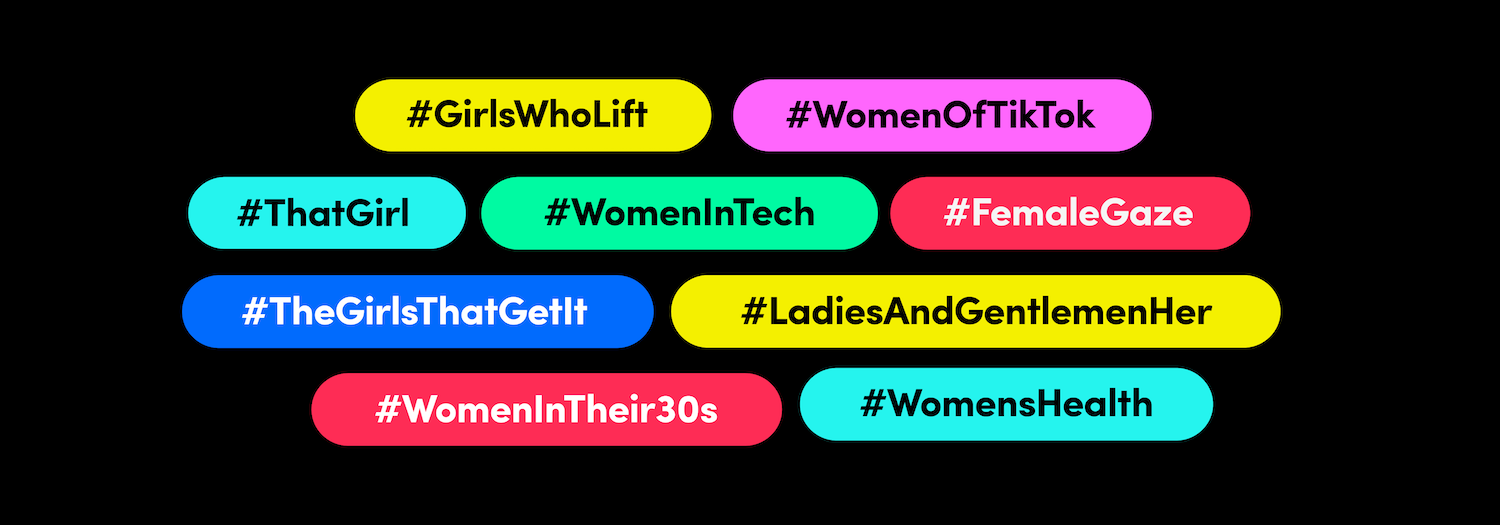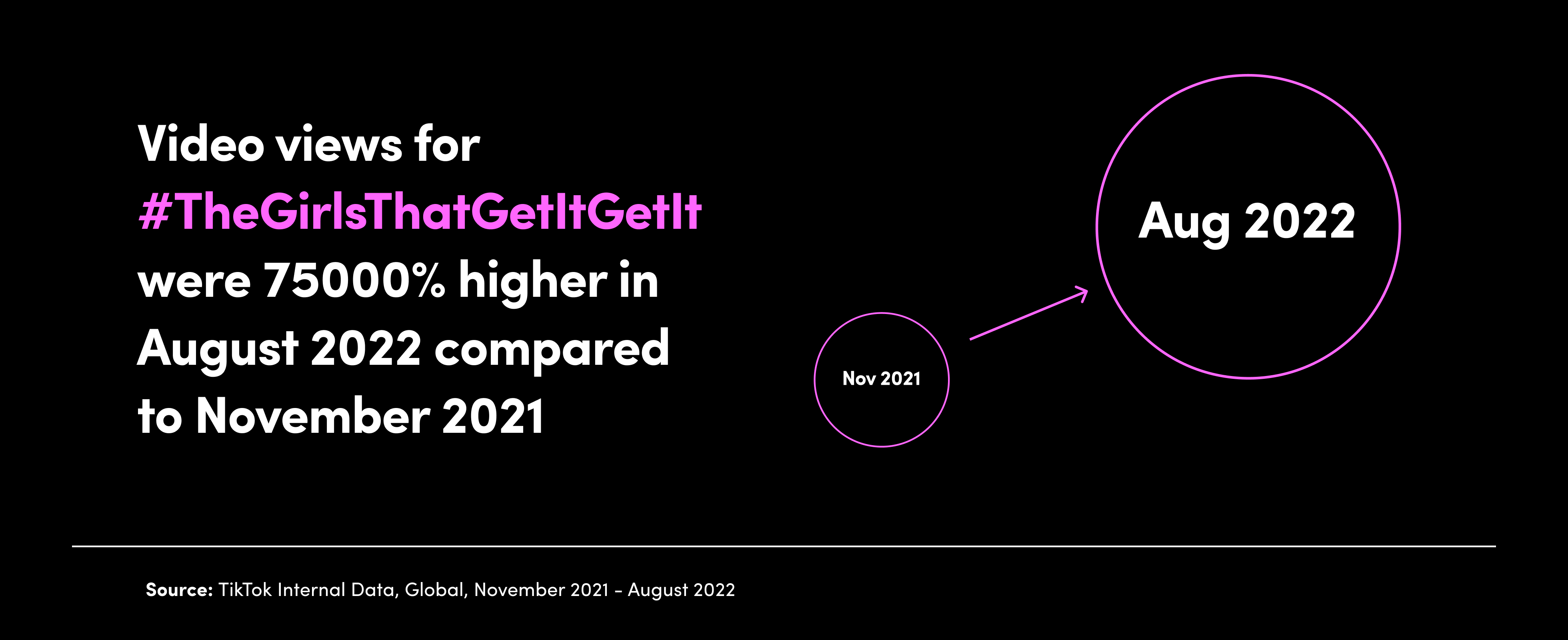
How trends help women break through on TikTok
A look at how TikTok is making it easier for women to be seen and heard online. Featuring insights from Creator @lyllistapper.
POV: You're a female creator trying to make digital content in 2022 and it's harder than ever to break through. The hurdles you face as a woman IRL exist online, too, and make it harder to be seen and connect with followers. It feels like unless you're white, wealthy, young, and in a straight-sized body, you're out of luck. What do you do?
If you ask creator Lylli Stapper, your best is to get on TikTok. Before downloading the app in 2020, she was active on other platforms, making content that accommodated the "societal norms and beauty standards" placed on her. But when she joined TikTok, she discovered a new realm of possibilities for reaching viewers and expressing herself.
"It's given me room to be heard and seen as a female creator. I've been able to pave my way through my own content and personality," she said.
We aren't saying that societal issues don't bleed on TikTok. But we've noticed, through tracking trends and research, that women find it easier to reach viewers on TikTok. 80% of women on the platform agree that anyone's posts can be successful and 81% of women agree that all you really need to succeed on TikTok is a smartphone and some creativity1,2.
There's three key reasons for this: The algorithm is built on interests and passions, not on following, which makes it much easier for people to connect with likeminded users. TikTok trends are an easy way for women to tap into existing creative frameworks to help share their stories and find their community. And this all contributes to a sense of camaraderie and inclusion among women on the platform. For marketers looking to reach women on TikTok, these are massive clues that can help drive campaign success on the platform.
Be a #GirlThatGetsIt
Reaching women on TikTok requires paying attention to the things they like. And we don't mean looking at which women enjoy shopping and have made a purchase in the last six months—that's important for conversions, and can be a part of how you build your strategy. But the FYP has built an environment where content speaks to people's emotional, artistic, and cultural interests as much as their objective online behaviors.
Take, for example, #TheGirlsThatGetIt trend. Women use it to talk about their hyper-specific habits—like weightlifting techniques and water bottle usage. The FYP, which is fine-tuned to show people content they'll care about, puts those videos in the feeds of people who are likely to relate to it, which helps women discover all the niche things they have in common.

The more women connect over their specific interests, the more willing they are to share all parts of themselves. Lylli's seen women on TikTok engaging in "traditionally masculine" hobbies, like sports, film direction, and business management—things they may not feel comfortable discussing elsewhere. 72% of women on TikTok agree that they feel safe exploring and expressing sides of their identity on TikTok that their friends or family might not necessarily approve of3.
What this means for marketers
Follow as many women as you can on TikTok and create a trend bank, where you take note of the topics and trends that come up often in their content. That'll help you reach them where they're at, and talk to them in a way that really resonates.
If you're in a role that involves making creative decisions for a TikTok campaign, then you should strive to watch as many TikTok as possible. Show this article to your boss and tell them, the TikTok marketing lady is saying I have to spend, like, an hour of my workday watching TikTok videos because it will help me understand what women care about.
Trends are open to anyone
On other platforms, there's a relatively narrow scope of trends that help women get engagement, usually in the realm of beauty, lifestyle, fitness, and emotional confessionals. But what if a woman just wants to post about the work she's doing on her bike? Or talk about her job without baring her soul? What if she does want to bare her soul, but about something that's taboo for women to discuss, like choosing to be child-free?
These are the kinds of things we see women sharing on TikTok. 71% of women on TikTok feel that they can be honest and genuine on the platform and 66% of women on TikTok agree that it feels like a safe space4.
Lylli has felt more free to experiment with different topics on TikTok. "My more comedic style, showcased in videos where I dye my hair and do short-form comedy skits, is a form of content that I don't tend to post elsewhere, because it doesn't adhere to the gender roles placed on me," she said.
Even when women do make content about topics that are typically considered feminine, they're able to do it in more honest and subversive ways. Lylli, for instance, makes beauty-related content. (Some of her most popular videos are of her dying her own hair.) But she makes them with a funny edge, which keeps it true to her identity and makes the videos more entertaining and engaging.
What this means for marketers
Once you have a trend bank going, where you keep track of the things that women are talking about, you can make content that leverages those trends.
Example: Many women have been using the #DayInTheLife trend to film their day-to-day lives, whether they're a student, fork lift operator, or NYC influencer. Try posting a #DayInTheLife video of you doing your job, emphasizing the aspects of your brand you'd like to promote to women. (75% of users agree that brands' videos should feel like a view into their employees' everyday, real lives, so it's a format our users would like to see5.)
If you want to explore even more trends to try out, check out our Creative Center, where you can browse the top hashtags, songs, creators, and videos by region.
Don't go for the obvious choice
Lylli has had positive experiences working with brands on TikTok and she's always felt free to make videos in her own creative style. She mostly gets approached for partnerships related beauty and lifestyle products, but her true passions lie in screenwriting, filmmaking, and photography.
"Behind the camera, I'm operating different equipment [related to] lighting, editing, and audio processing. These are the products I am well-equipped to speak about and promote," she said. But those aren't where the opportunities come from. She's not exactly an expert in beauty or lifestyle products, either, but her "page checks the boxes for brands geared in that realm to reach out and collaborate." The same can't be said for brands in the production and filmmaking spheres.
"I know that's because I haven't demonstrated these skills in front of the camera on my page. But even if I did, I have serious doubts companies would choose me as a woman to be their first choice as ambassador in a male-dominated field."

What this means for marketers
Choose Creators that align with the values that you're trying to promote, and trust that they'll will nail the brief, even if they aren't the most obvious choice for the campaign. This will open the door to people like Lylli, who want to explore new, hard-to-enter industries.
Plus, the entertainment value of a video matters a lot more than the "qualifications" of the Creator; 77% of women on TikTok agree that people judge posts on TikTok by whether they're good or not, not by who made them6. Users are drawn to Creators like Lylli because they're relatable, honest, and creative. People will listen to what she has to say—whether she's promoting shampoo or cameras.
Check out the TikTok Creator Marketplace to browse Creators to work with. There, you might just discover the star of your next campaign, and stumble across unexpected choices.
"I feel it's time for marketers to begin to choose the non-obvious pick to promote their company. They may be pleasantly surprised," Lylli said.
1, 2, 3, 4, 5, 6: TikTok Marketing Science Global Community and Self-Expression Study 2021 conducted by Flamingo.